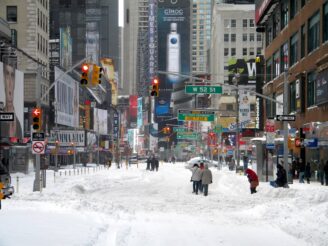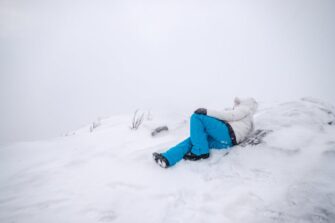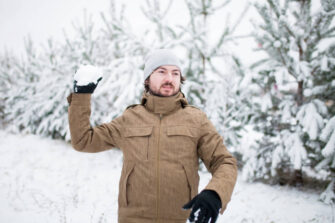
We Command the Respect of our Adversaries
Table of Contents
As a general rule, New York City property owners are responsible for safeguarding the public against the effects of dangerous weather conditions—like snow and ice—within a reasonable period of time after they occur. A property owner may also be responsible for failing to adequately clear snow/ice that thaws and then re-freezes, causing an accident. Failure to uphold these duties could result in liability for injuries caused by an individual’s slip and fall accident.
Whether or not a property owner is responsible for these types of accidents depends on the specific facts surrounding the occurrence. For example, your lawyer must investigate both the location of the hazardous condition as well as the length of time the condition existed prior to the accident.
These are only a few of the factors that must be considered when evaluating a property owner’s liability for slip and fall accidents on snow and ice. To discuss your accident and whether you may have a case against a property owner, contact the Recommended New York City slip and fall attorneys at Belluck & Fox, LLP for a free case review.
Determining Responsibility for a Slippery Walkway
A Property Owner’s Duties
Under New York’s Administrative Code, property owners are generally responsible for installing, repairing and maintaining the sidewalk adjoining their property. In other words, if you slip and fall on a New York City sidewalk, liability typically rests with the owner of the property that abuts the sidewalk where the accident occurred.
The owner/landlord is also responsible for snow and ice accumulation that occurs in the following locations:
- The front steps and stoop of a building.
- Entrances to stores, offices and other commercial settings.
- Parking lots.
- Pathways leading from the sidewalk into the premises.
- Floors and stairwells situated inside the building or residence.
 Responsibility for clearing these areas of snow and ice may, on occasion, be shared with other parties such as a building manager, maintenance company, outside contractor, or even certain tenants.
Responsibility for clearing these areas of snow and ice may, on occasion, be shared with other parties such as a building manager, maintenance company, outside contractor, or even certain tenants.
Ongoing Storms and the Four Hour Rule
Owners, of course, can’t reasonably be expected to clear hazardous wintry conditions the moment they appear. Rather, a property owner is typically afforded four hours after a storm ceases to remove dangerous snow and ice. If the storm occurs overnight, the owner has until 11 a.m. the following morning to address any dangerous conditions. If the winter storm is ongoing, however, the property owner is not required to clear their property until the storm ends.
Proving the Owner’s Negligence
Keep in mind that a property own isn’t necessarily liable for every slip and fall accident that occurs on their premises.
In order to prevail in a slip and fall lawsuit, you must demonstrate that the owner was responsible for maintaining the sidewalk or walkway where the accident occurred and that they knew about (had “actual notice”) or should have known about (had “constructive notice”) of the hazardous condition prior to your fall.
 In the case of “actual notice” you might be able to prove that the property owner knew about the dangerous condition if the owner was issued a citation for failure to remove snow or if another individual previously advised the owner of the dangerous condition. In the case of “constructive notice” an argument of due diligence might suffice. For example, if a full day had passed between the time the storm ended and the time of your fall, it may be reasonable to infer that the owner should have known about the condition, yet failed to timely and properly remedy the hazard.
In the case of “actual notice” you might be able to prove that the property owner knew about the dangerous condition if the owner was issued a citation for failure to remove snow or if another individual previously advised the owner of the dangerous condition. In the case of “constructive notice” an argument of due diligence might suffice. For example, if a full day had passed between the time the storm ended and the time of your fall, it may be reasonable to infer that the owner should have known about the condition, yet failed to timely and properly remedy the hazard.
Cases Against New York City
Under limited circumstances a municipality, like the City of New York, may be responsible for clearing sidewalks of snow and ice. Indeed, the City and/or government agencies are almost always responsible for maintaining certain public spaces, including subway stairs and platforms, streets and roadways, and municipal parks and playgrounds. But even under these circumstances government agencies typically enjoy various legal protections that can make it difficult to bring cases against them.
Still, it is possible to sue the City or a division thereof (e.g. the New York City Transit Authority or Department of Parks & Recreation) for a dangerous condition that caused a slip and fall accident. Similar to cases against a business or property owner, you must prove that the municipality had notice of the icy/snowy condition. It is important to be aware that the deadline for filing a claim against the City and other government entities can be as short as 90 days.
Slip & Fall? Talk to Belluck & Fox, LLP.
Liability surrounding a slip and fall accident can be complicated and varies depending on the specific circumstances surrounding your accident. Contact a top rated personal injury attorneys at Belluck & Fox, LLP for help with your slip and fall accident claim. To know more about your legal rights and options, talk to our experienced New York injury attorneys at Belluck & Fox, LLP for a no-cost, no-obligation consultation.